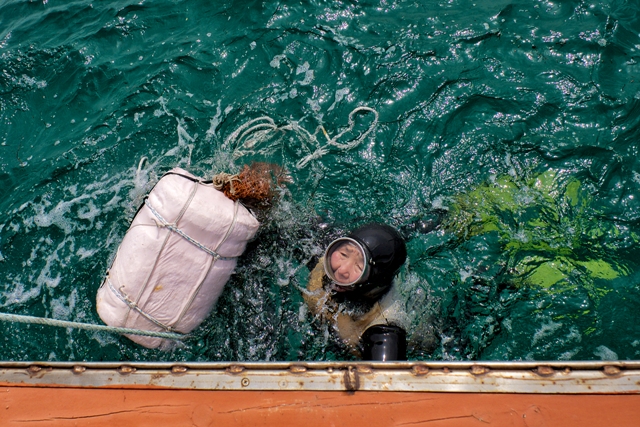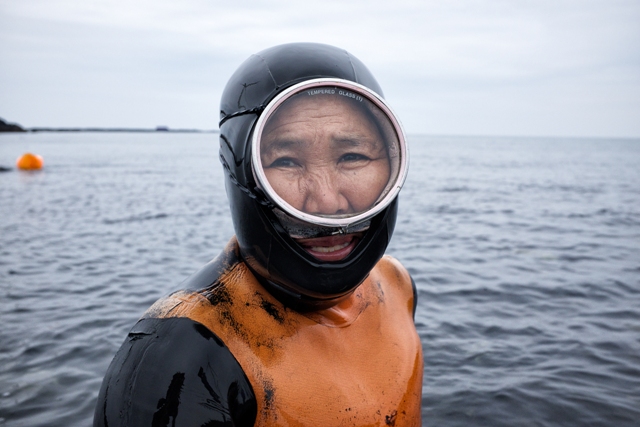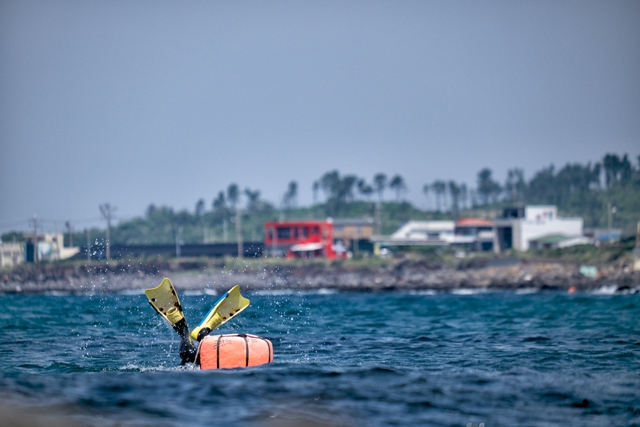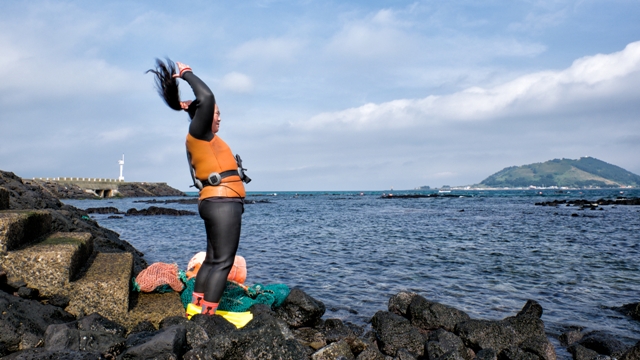| |
 |
|
| ▲ Jose’s pictures show the haenyeo as they go about their daily work Photo by Jose Jeuland |
Jose Jeuland is a triathlete and photographer. He came to Jeju earlier in the year to compete in a 50km race in Hallasan National Park and to take photos of Jeju’s beautiful natural landscape.
While here, however, he discovered Jeju’s unique haenyeo and as a photographer realized that he had to use this opportunity to take pictures of the island’s unique diver women.
His pictures, in both full color and black and white, show the haenyeo as they go about their daily work of diving and catching fish.
It is, of course, the fact that this is a regular daily event for the haenyeo that makes what they do so wonderful and interesting to the outsider.
Jose says he first became interested in the haenyeo for a variety of reasons. As well as the unique nature of their job and the techniques they use to fish, he was also drawn to the culture of the haenyeo including things such as their ancestral culture and their dress code.
| |
 |
|
| ▲ Photo by Jose Jeuland |
Despite originally becoming an athlete, Jose became interested in photography after looking through photo books.
He decided to pick up the camera himself after spending time in foreign countries training for races but feeling “a certain frustration where I was unable to take time to observe the locals and their culture due to the intense training prior to my race.”
He realized that photography is a “fascinating way to discover the world and the people in it” and you can certainly see this mindset in his haenyeo photos.
Focusing on the haenyeo while they are working, his photos give an insight into the way haenyeo work and interact that is not seen by many people.
Of course, for the haenyeo themselves, there is nothing unusual about what they do.
| |
 |
|
| ▲ Photo by Jose Jeuland |
As people who have been in and around the water for their whole lives, Jose noticed that they were as natural as fish in the water. Despite the advanced age of many of the divers, things such as entering and leaving the water were incredibly natural to them.
It is this grace and beauty in such an unfamiliar surrounding that make the pictures so striking. In each shot, the divers grab the attention of the camera.
This is especially the case in the pictures of the older women because seeing them diving is such a contrast to what we usually expect to see from the older generation.
Jose thinks one of the most touching parts of seeing people of this age in the water is that it allows you to “imagine your grand mums and try to imagine her doing it! And I can tell you for most of us in the world the reality is very far.”
As an athlete not unfamiliar with running 50km race, Jose was certainly able to appreciate the physical nature of the haenyeo’s work.
| |
 |
|
| ▲ Photo by Jose Jeuland |
This similarity continues in the way the haenyeo bond before going out to sea.
He said “It was similar to what we experience between athletes - Before a group training or a competition, they would be chatting, joking, focused, giving advice while some relax and unwind”
Of course, the age of the haenyeo, some of them even work into their 80s, was an eye opener. However, Jose thought the females divers are good examples of how to grow older and stay fit.
He also thought that in a world where being old is often a synonym for being alone, the camaraderie found amongst the older divers was eye opening.
“While alternatively you can also find people who are not active at all and are quick to lose their physical capacity. Obviously, one has to know that you should not go beyond their physical limit and endanger their lives.”
| |
 |
|
| ▲ Photo by Jose Jeuland |
Of the final photographs, Jose was happy with how they turned out. He was keen to point out to anyone unfamiliar with Jeju and their haenyeo that it is a real thing that people do every day, not a show put on to show off a relic from the past.
In the future, Jose plans to travel back to Jeju to conduct more shoots of the Haenyeo, specifically, he wants to do “a close-up shoot, underwater shoot and formulate a short video.”
He said he also “plans to organize a project to showcase my visuals about the haenyeo in Singapore for the first time.”
As well as his photos, his athletic training will not stop. Next, he will be racing on September 11 in the Challenge Triathlon in Nha Trang, Vietnam. It will be a half Ironman distance. He also wants to push himself to do a 100km Trail Run, which would be a first for him.
Perhaps during his next race, the thought of the haenyeo and their incredible drive and athleticism will help him push through those final few barriers.
Click here to take a look at the full collection of Jose's haenyeo photos. |
























